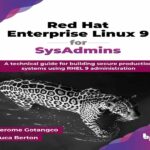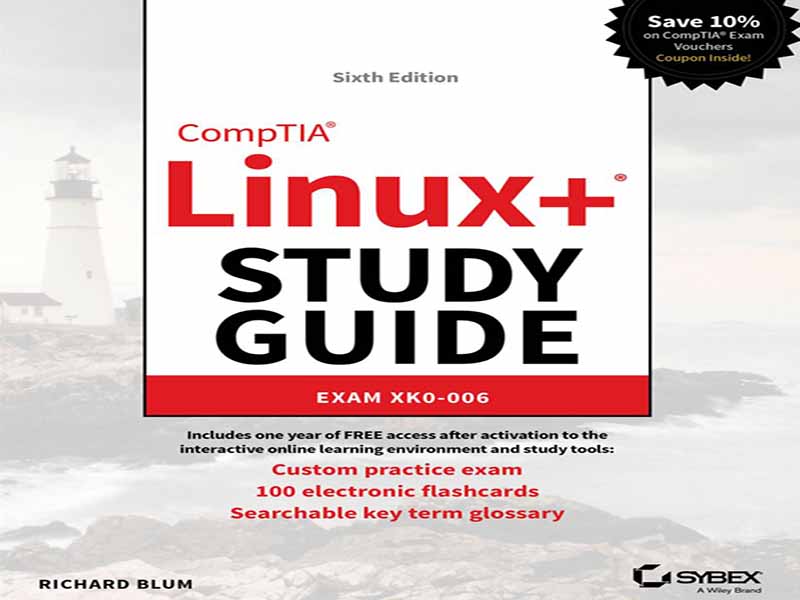- عنوان کتاب: CompTIA Linux+ Study Guide, ed 6
- نویسنده: Richard Blum
- حوزه: آموزش لینوکس
- سال انتشار: 2025
- تعداد صفحه: 1345
- زبان اصلی: انگلیسی
- نوع فایل: pdf
- حجم فایل: 10.8 مگابایت
این کتاب شامل ۳۱ فصل است که پیرامون حوزههای مختلف هدف آزمون لینوکس پلاس سازماندهی شدهاند: فصل ۱، «آمادهسازی محیط شما»، به شما در یافتن و نصب یک توزیع لینوکس برای آزمایش لینوکس و کار بر روی تمرینهای کتاب کمک میکند. فصل ۲، «مقدمهای بر سرویسها»، شما را با برنامههای کاربردی و کاربردهای مختلف سرور که معمولاً در لینوکس استفاده میشوند، آشنا میکند. فصل ۳، «مدیریت فایلها، دایرکتوریها و متن»، دستورات اساسی لینوکس برای کار با فایلها و دایرکتوریها از خط فرمان را پوشش میدهد. فصل ۴، «جستجو و تحلیل متن»، ابزارهای مختلفی را که لینوکس برای کار با فایلهای متنی ارائه میدهد، مورد بحث قرار میدهد. فصل ۵، «توضیح فرآیند بوت»، شما را به فرآیندهای داخلی نحوه شروع سیستم عامل لینوکس میبرد و نحوه سفارشیسازی فرآیند بوت لینوکس را به شما نشان میدهد. فصل ۶، «نگهداری راهاندازی سیستم و سرویسها»، با بحث در مورد دو روش مختلف مورد استفاده برای کنترل راهاندازی برنامهها، شما را با نحوه شروع برنامههای کاربردی توسط سیستم لینوکس در زمان بوت آشنا میکند. فصل ۷، «پیکربندی اتصالات شبکه»، نحوه راهاندازی سیستم لینوکس شما بر روی یک شبکه محلی را به همراه ابزارهای مختلف موجود برای کمک به عیبیابی مشکلات شبکه در سیستم لینوکس شما نشان میدهد. فصل ۸، «مقایسه رابطهای کاربری گرافیکی»، محیطهای دسکتاپ گرافیکی مختلف موجود در لینوکس را مورد بحث قرار میدهد. فصل ۹، «تنظیم گزینههای محلیسازی»، نحوه تغییر مجموعه کاراکترها و قالبهای تاریخ/زمان برای سیستم لینوکس شما را برای تطبیق با قالبهای مختلف مورد استفاده در کشورهای مختلف نشان میدهد. فصل ۱۰، «مدیریت کاربران و گروهها»، نحوه مدیریت حسابهای کاربری توسط لینوکس و نحوه اختصاص کاربران به گروهها برای مدیریت دسترسی به فایلها و دایرکتوریها را بررسی میکند. فصل ۱۱، «مدیریت ذخیرهسازی»، روشها و قالبهای مختلف ذخیرهسازی موجود در سیستم لینوکس را بررسی میکند. فصل ۱۲، «محافظت از فایلها»، به دنیای پشتیبانگیری، بایگانی و بازیابی دادهها میپردازد. فصل ۱۳، «مدیریت نرمافزار»، نحوه مدیریت برنامههای نرمافزاری توسط لینوکس و نحوه نصب بستههای نرمافزاری بر روی انواع مختلف توزیع لینوکس را توضیح میدهد. فصل ۱۴، «نگهداری ماژولهای هسته»، به چگونگی استفاده لینوکس از ماژولهای هسته برای پشتیبانی از سختافزار و نحوه مدیریت ماژولهای هسته در سیستم لینوکس شما میپردازد. فصل ۱۵، «اعمال مالکیت و مجوزها»، روشهای متعدد موجود برای محافظت از فایلها و دایرکتوریها در یک سیستم لینوکس را بررسی میکند. این فصل، مجوزهای استاندارد به سبک لینوکس و همچنین برنامههای پیشرفتهتر SELinux و AppArmor را که برای ارائه امنیت پیشرفتهتر برای سیستمهای لینوکس استفاده میشوند، مورد بحث قرار میدهد. فصل ۱۶، «بررسی روشهای دسترسی و احراز هویت»، روشهای مختلفی را که لینوکس میتواند برای احراز هویت حسابهای کاربری، چه به صورت محلی و چه در محیطهای شبکه، استفاده کند، بررسی میکند. فصل ۱۷، «پیادهسازی سرویسهای ثبت وقایع»، نشان میدهد که لینوکس چگونه رویدادهای سیستم را ثبت میکند و چگونه میتوانید از گزارشهای سیستم لینوکس برای عیبیابی مشکلات در سیستم لینوکس خود استفاده کنید. فصل ۱۸، «نظارت بر فایروالهای لینوکس»، شما را در نحوه محافظت از سیستم لینوکس خود در یک محیط شبکه راهنمایی میکند. فصل ۱۹، «پذیرش بهترین شیوههای امنیتی»، روشهای رایج مختلفی را که میتوانید برای ایمنتر کردن محیط لینوکس خود پیادهسازی کنید، مورد بحث قرار میدهد. فصل ۲۰، «تحلیل ویژگیهای سیستم و رفع مشکلات»، روشهای موجود برای عیبیابی انواع مختلف مشکلات لینوکس را بررسی میکند. این شامل مشکلات شبکه، مشکلات ذخیرهسازی و مشکلات سیستم عامل میشود. فصل ۲۱، «بهینهسازی عملکرد»، نحوه مدیریت برنامههای در حال اجرا توسط لینوکس و ابزارهایی که برای کنترل رفتار این برنامهها در دسترس دارید را مورد بحث قرار میدهد. فصل ۲۲، «بررسی مشکلات کاربر»، نحوه عیبیابی و رفع مشکلات رایج مربوط به کاربر، مانند عدم امکان دسترسی به فایلها یا دایرکتوریهای خاص در سیستم را بررسی میکند. فصل ۲۳، «برخورد با دستگاههای لینوکس»، شما را با انواع مختلف دستگاههای سختافزاری که لینوکس پشتیبانی میکند و بهترین روش برای راهاندازی آنها در سیستم لینوکس شما آشنا میکند. فصل ۲۴، «عیبیابی مشکلات برنامه و سختافزار»، بر روشهای عیبیابی برای حل مشکلات ذخیرهسازی، برنامه و شبکه که ممکن است در سیستم لینوکس شما رخ دهد، تمرکز دارد. فصل ۲۵، «استقرار اسکریپتهای Bash»، نحوه ایجاد اسکریپتهای شخصی برای خودکارسازی وظایف رایج در لینوکس را مورد بحث قرار میدهد. فصل ۲۶، «مفاهیم پایتون»، به اصول برنامهنویسی پایتون در حوزه مدیران سیستم میپردازد. فصل ۲۷، «خودکارسازی کارها»، با نشان دادن نحوه زمانبندی اسکریپتهایتان برای اجرا در زمانهای خاص روز، هفته، ماه یا سال، به موضوع اسکریپتهای Bash میپردازد. فصل ۲۸، «کنترل نسخهها با Git»، دنیای کنترل نسخه نرمافزار را بررسی میکند و نشان میدهد که چگونه میتوانید از نرمافزار رایج کنترل نسخه Git برای مدیریت برنامهها و اسکریپتهای خود استفاده کنید. فصل ۲۹، «درک مفاهیم ابر و مجازیسازی»، شما را با اصول اولیه ابر و نحوه استفاده از لینوکس برای ایجاد محیط محاسبات ابری خود آشنا میکند. فصل ۳۰، «بازرسی سرویسهای ابر و مجازیسازی»، h را نشان میدهد.
This book consists of 31 chapters organized around the different objective areas of the Linux+ exam: Chapter 1, “Preparing Your Environment,” helps you with finding and installing a Linux distribution to use for experimenting with Linux and working on the exercises in the book. Chapter 2, “Introduction to Services,” introduces you to the different server applications and uses you’ll commonly see used in Linux. Chapter 3, “Managing Files, Directories, and Text,” covers the basic Linux commands for working with files and directories from the command line. Chapter 4, “Searching and Analyzing Text,” discusses the different tools Linux provides for working with text files. Chapter 5, “Explaining the Boot Process,” takes you into the inner processes of how the Linux operating system starts, showing you how to customize the Linux boot process. Chapter 6, “Maintaining System Startup and Services,” walks you through how the Linux system starts applications at boot time by discussing the two different methods used for controlling program startups. Chapter 7, “Configuring Network Connections,” shows how to get your Linux system working on a local area network, along with the different tools available to help troubleshoot network problems on your Linux system. Chapter 8, “Comparing GUIs,” discusses the different graphical desktop environments available in Linux. Chapter 9, “Adjusting Localization Options,” shows how to change the character set and date/time formats for your Linux system to accommodate the different formats used in various countries. Chapter 10, “Administering Users and Groups,” explores how Linux handles user accounts and how you can assign users to groups to manage access to files and directories. Chapter 11, “Handling Storage,” examines the different storage methods and formats available in the Linux system. Chapter 12, “Protecting Files,” dives into the world of data backups, archiving, and restoring. Chapter 13, “Governing Software,” explains how Linux manages software applications and how to install software packages on the various Linux distribution types. Chapter 14, “Tending Kernel Modules,” discusses how Linux uses kernel modules to support hardware and how you can manage the kernel modules on your Linux system. Chapter 15, “Applying Ownership and Permissions,” explores the multiple methods available for protecting files and directories on a Linux system. It discusses the standard Linux-style permissions as well as the more advanced SELinux and AppArmor applications used to provide more advanced security for Linux systems. Chapter 16, “Looking at Access and Authentication Methods,” explores the different methods Linux can use to authenticate user accounts, both locally and in network environments. Chapter 17, “Implementing Logging Services,” shows how Linux logs system events and how you can use the Linux system logs for troubleshooting problems on your Linux system. Chapter 18, “Overseeing Linux Firewalls,” walks you through how to protect your Linux system in a network environment. Chapter 19, “Embracing Best Security Practices,” discusses various common methods you can implement to make your Linux environment more secure. Chapter 20, “Analyzing System Properties and Remediation,” explores the methods you have available to troubleshoot different types of Linux problems. This includes network issues, storage issues, and operating system issues. Chapter 21, “Optimizing Performance,” discusses how Linux handles running applications and the tools you have available to control how those applications behave. Chapter 22, “Investigating User Issues,” explores how to troubleshoot and fix common user-related issues, such as the inability to access specific files or directories on the system. Chapter 23, “Dealing with Linux Devices,” walks you through the different types of hardware devices Linux supports and how best to get them working on your Linux system. Chapter 24, “Troubleshooting Application and Hardware Issues,” focuses on troubleshooting methods for solving storage, application, and network problems that may occur on your Linux system. Chapter 25, “Deploying Bash Scripts,” discusses how to create your own scripts to automate common tasks in Linux. Chapter 26, “Python Concepts,” touches on the basics of Python programming as it would apply to system administrators. Chapter 27, “Automating Jobs,” follows up on the topic of Bash scripts by showing you how to schedule your scripts to run at specific times of the day, week, month, or year. Chapter 28, “Controlling Versions with Git,” explores the world of software version control and demonstrates how you can use the common Git version control software to manage your own applications and scripts. Chapter 29, “Understanding Cloud and Virtualization Concepts,” walks you through the basics of what the cloud is and how to use Linux to create your own cloud computing environment. Chapter 30, “Inspecting Cloud and Virtualization Services,” demonstrates how to implement cloud computing software in Linux. Chapter 31, “Orchestrating the Environment,” discusses how you can use containers and orchestration engines in your Linux environment to control application development environments and deploy applications in controlled environments.
این کتاب را میتوانید از لینک زیر بصورت رایگان دانلود کنید:
Download: CompTIA Linux+ Study Guide, ed 6



































نظرات کاربران